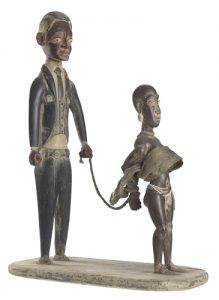Angelica Cruz
ENG-302
Prof. Kappes
March 18,2018
European Standards of Beauty During the 17th Century Trans-Atlantic Slave Trade

The history of the African people enslaved by European slave traders has been portrayed in countless artistic expressions including literature and woodcarving. These mediums often depict the African people as being less than ideal in terms of what is considered aesthetically beautiful. The European standard of beauty revolves around the idea that having features that resemble those of European decent are favored above all other ethnicities. For example an enslaved African with physical features which are parallel to those of European decent, are considered to be of high-caliber. This old-world standard of beauty can be found in various periods of time as far back as the 17th century where it is employed in the art form of woodcarving of Ghana, as well as in English novelist Aphra Behn’s novella Oroonoko.
Artists of various mediums have documented the African image using several methods such as woodcarving. The woodcarving entitled: “Woodcarving of a slave trader with enslaved female”, found in The National Museum of African American History and Cultures Digital Collection, displays Eurocentric ideals of beauty. This particular wood carving displays a male slave trader and young enslaved female. The man holds the young woman on a rope, which binds her hands together, and also has a lasso around her neck. The figures represent enslaved Africans from two perspectives: one that adheres to the Eurocentric standards of beauty and one that contradicts this ideal beauty standard. The man in the woodcarving exemplifies the European: he has fine facial features and is dressed in Western styled clothing with a jacket, waist coat and trousers, tie, white dress shirt, laced-up up shoes. In comparison to the male figurine, the female figurine’s facial features are greatly exaggerated: Her lips and nose are quite broad, perhaps to fit a stereotype Europeans believed to be accurate amongst those of African descent. The young female is bald and her ears are weighted down by her enormous earrings, which may be a symbol of beauty in her native land. However, the large earrings come across as primitive in the Western world. She is scantily dressed with only a small bit of cloth on her chest, as well as her waist which is adorned with small beads. The physical features of the young female are not proportion to her stature; she is significantly smaller that the man and her breasts and posterior are rather large. In comparison to the man, she is portrayed more as a caricature, than a human. The man’s physical characteristics are seen as aesthetically beautiful and there for making his appearance much more acceptable to a Western audience. The man’s facial characteristics seems to have benefited him, giving him a position of authority amongst other enslaved people, which is also represented in the height of the slave trader when compared to the enslaved women. Aphra Behns protagonist Oroonoko has physical and facial descriptions that are quite similar to those characteristics seen in the male figurine.
Aphra Behn most certainly employs these ideals concerning the European standard of beauty in her novella Oroonoko, when she describes her protagonist: “His nose was rising and Roman instead of African and flat. His mouth, the finest shaped that could be seen, far from those great turned lips which are so natural to the rest of the Negroes. The whole proportion and air of his face was so noble exactly formed that, bating his colour, there could be nothing in nature more agreeable and handsome” (15). This description of Oroonoko illustrates a man who is quite handsome according to European standards. Behn’s use of the words “roman” and “noble”, gives the audience the sense that Oroonoko was far more superior in comparison to other Africans from Coramantien, as these words connote characteristics of classical beauty, and aristocratic status.
Aphra Behn considers the young prince to be a work of art that could not be replicated: “He was pretty tall, but of a shape the most exact that can be fancied; the most famous statuary could not form the figure of a man more admirably turned from head to foot”(15). Oroonoko was even perhaps more beautiful than Michelangelo’s David, in the eyes of our narrator, the fictional Aphra Behn. Meanwhile, Behn usess words such as a “gloomy race” (13) that are rather disheartening to describe the natives of Coramantien. Here, we see how the term “gloomy” is used to describe the Coramantien people as physically dark and perhaps as an unattractive group when compared to the prince. Although, Behn admires Oroonokos appearance, she later qualifies her description by adding to that his skin-color is perhaps is his only downfall: “The whole proportion and air of his face was so noble exactly formed that, bating his colour, there could be nothing in nature more agreeable and handsome” (15). Behn once again implies that to resemble those of European decent was favored during the 17th century transatlantic slave trade.
Eurocentric values and ideals were prominent in the art of the 17th century, as depicted in classic English literature such as Oroonoko, as well as the woodcarving from Ghana of the slave trader and his slave. These ideals became increasingly difficult to expel throughout the slave trade. This Old World standard of beauty became idolized and romanticized throughout the New World. We are there for lead to the belief that to resemble those of European decent was to be the accepted model of refinement in those of a particular native group, in this case the enslaved people of African descent.
Works Cited

